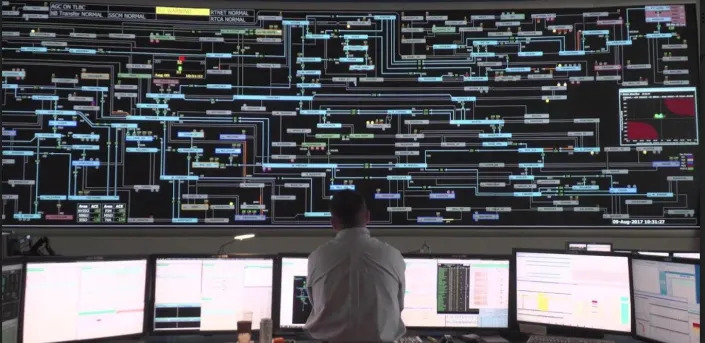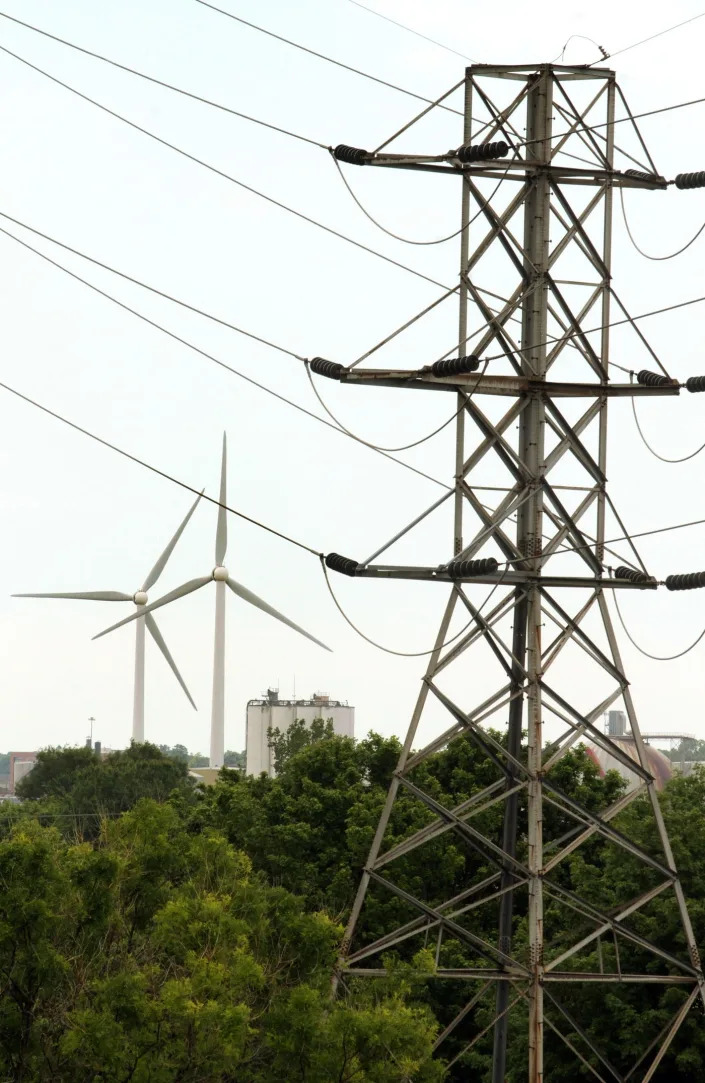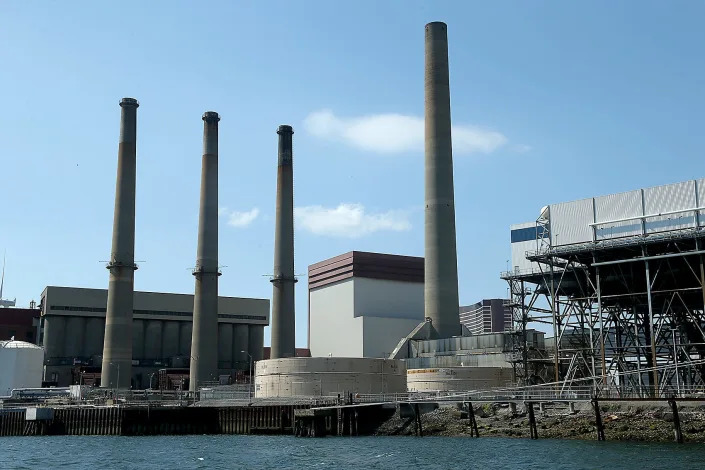What the Christmas Eve power plant failures say about New England's regional grid system
Hadley Barndollar, USA TODAY NETWORK
Mon, January 23, 2023
As many New Englanders cooked Christmas Eve dinners and gathered in living rooms alight with decorations, an energy debacle was occurring silently in the background.
The region's electric grid operator, ISO New England, had called upon "any resource that could respond quickly enough to be online for the evening peak." The "hail Mary" call of sorts came as part of emergency protocol prompted by several power plants that failed to perform as scheduled during peak electricity demand. The plant failures resulted in a shortage of operating reserves amid cold temperatures, storm conditions and power outages throughout much of the region.
Prices in the real-time wholesale energy market turned ISO's interactive map red, spiking to more than $2,000 per megawatt-hour during the 2.5-hour period. In comparison, the average price for December was $130.79 per megawatt-hour.
A larger fiasco was avoided by other power plants able to step in at short notice, and ISO New England has since explained the scenario as a short-term capacity deficiency. But the Christmas Eve event opened a Pandora's box of debate across the region as to what really occurred — and how the shortfall speaks to the larger issues faced by New England's electric grid. It brought to the forefront questions about winter reliability, pipeline capacity and the much-anticipated bridge to a renewable energy future as the region grapples with weaning off fossil fuels.
Learn more:What is ISO New England? Why the regional electric grid matters.

This map shows the real-time price of wholesale electricity on Christmas Eve as New England experienced a failure of certain power plants to step in and feed the electric grid during peak demand.
Mireille Bejjani, co-director of climate advocacy organization Slingshot and facilitator of the "Fix the Grid" campaign, warned that the events of Dec. 24 could have transpired into something "a lot worse," like rolling blackouts.
Bejjani called the scenario "an alarming indication that our grid is in dire need of some major changes to ensure resilience and reliability."
While ISO New England said it will not disclose information about the individual power plants that didn't perform, it did announce that the plants face $39 million in penalties. The grid operator has since issued a handful of public statements with its account of what occurred, including one last week as an attempt to "help correct any confusion, misinformation and misunderstanding resulting from various news stories and social media posts." It also released a play-by-play of the decisions made that night.
ISO New England:Power plants face millions in penalties after failures during Christmas Eve storm
"Our operating procedures are designed to manage through such a situation," ISO New England spokesperson Ellen Foley said this week. "[The procedures] have been around for more than three decades to manage through capacity deficiencies, such as the one that occurred on Christmas Eve."
It's unlikely ratepayers will be impacted by the exorbitant wholesale prices from the evening, ISO New England said, because of the way the region sets its retail prices for months at a time.

ISO New England is the operator of the regional electric grid, one of seven entities like it around the country. Pictured is ISO's control room in Holyoke, Massachusetts.
ISO New England says the culpable power plants weren't performing due to cold temperatures or mechanical problems, not because of inadequate fuel supplies. But some want more transparency about the power generators that didn't do their jobs that night.
"Until they give us the mix of failures, it's still an open question for me," said Nathan Phillips, an Earth and environment professor at Boston University and newly elected member of ISO New England's Consumer Liaison Group.
New England's natural gas pipeline capacity and what happens in winter
Natural gas is used to fuel power plants to generate electricity, while also fueling home heating and appliances. All the gas that comes into New England serves both purposes. On the coldest days of the year, explained Bejjani, home usage takes priority over power plants.
"If there is a constraint, a higher need than usual, power plants are the first taken off the list as recipients of that limited supply," she said.
For this reason, ISO New England puts out annual winter reliability messaging, often warning of the potential for electricity blackouts during prolonged cold spells if power plants don't have enough fuel. Although ISO maintains natural gas supply was not the issue on Christmas Eve, data shows the New England grid was powered by majority oil (34%) during peak demand that night, an unusual shift to a dirtier fossil fuel that typically makes up less than 1% of power annually. Power generators will often switch to oil if gas becomes too expensive or there is a supply shortage.
New England has increased its dependence on natural gas over the years — more than 50% of its annual fuel mix — but domestic infrastructure to deliver it remains the same. The region does not produce any natural gas of its own and instead has to import it all through pipelines or foreign vessels carrying liquified natural gas. Simultaneously, New England is generally not welcome to the idea of new pipeline infrastructure.
When nuclear power plants close,greenhouse gas emissions increase. Why you should care.
In 2016, for example, Kinder Morgan, one of the largest energy infrastructure companies, canceled its plans to build a $3.3 billion Northeast Energy Direct pipeline to connect its Tennessee Gas system to Massachusetts, New Hampshire and Connecticut. The pipeline garnered widespread opposition from environmentalists, lawmakers and ratepayers.
Years of opposition in the state of New York prevented four pipelines from being constructed, impacting the entire Northeast.
Amy Boyd, vice president of climate and clean energy policy at the Acadia Center, said dedicating money and resources to building new pipeline capacity would be counterintuitive to the clean energy future, one in which five of six New England states have legally binding goals to reduce greenhouse gas emissions.

Transmission lines are pictured in Rhode Island, with the Narragansett Bay Commission's wind turbines in the background.
"If we spend our money investing in these big pipelines, we then need to get our use out of them or they become a stranded asset," Boyd said. "Are we still going to be on the highway of using fossil fuels for a bit longer? Yes, but we need to be actively looking for the exit and building the exit."
ISO New England has said it does not expect any additional natural gas pipeline infrastructure to be built in New England and has instead turned its efforts to advocating for more access to liquified natural gas. Last August, it penned a letter to U.S. Department of Energy Secretary Jennifer Granholm, pushing for exemptions from the federal Jones Act for New England to access domestic liquified natural gas by tanker if emergency conditions warrant it. Currently, the Jones Act prohibits nonqualifying vessels from transporting cargo between two U.S. ports.
Increasing New England's natural gas supply or reducing demand?
ISO New England has continued to call on fossil fuel resources in the name of grid reliability, saying it's mandated by its overseer, the Federal Energy Regulatory Commission, to be "fuel and technology-neutral."
Last year, for example, ISO lobbied for the continued operation of the liquid natural gas terminal at Mystic Generating Station in Everett, Mass., beyond 2024 — its planned retirement — to maintain reliability as renewables slowly come online.

The Mystic Generating Station is a power plant in Everett, Massachusetts.
ISO New England CEO Gordan van Welie recently wrote in a Boston Globe editorial that shifting to a grid powered by renewables doesn't happen at the flip of a switch. While clean energy advocates largely agree with him, they do believe the regional grid operator has more of a role to play in fast-tracking that future and cluing ratepayers into the larger system as active partners, not just consumers.
On Christmas Eve, ISO New England didn't issue any public messaging asking for people to conserve energy, but some feel it should have.
"And that gets right at the heart of what I think is the problem, at the heart of this strange middle period we are in [between fossil fuels and renewable energy]," said Boston University's Phillips. "We have less than 10 million people in New England that are staring into an energy emergency, a war emergency with the Ukraine, the spiking prices, and ISO is silent about ratepayer power to do intentional demand response."
Phillips, Bejjani and Boyd all pointed to demand reduction as the bridge to clean energy. Instead of increasing natural gas supply, they said, New England ratepayers can focus on ways to reduce their use.
"There is a hunger on the part of ratepayers, residents and consumers to be active participants in the energy landscape, to know what's going on and to be able to make decisions accordingly," said Bejjani.
On the other hand, Boyd said issuing widespread energy conservation alerts to the public "could erode people's confidence" in the grid's reliability.
"People generally want their energy to be invisible," she said. "You turn on your heat; it works. You don't really care where it's coming from or why. ISO New England rightfully takes reliability as its No. 1 job. So having to say to the public on a relatively frequent basis, 'Hey we need your help, we need you to conserve...'"
But, said Boyd, there are ways to get at load control by building demand response into the system earlier, such as involving ratepayers who are already paying attention to their energy use and want to voluntarily conserve.
Decreasing demand for the individual consumer could be as simple as running the dishwasher or dryer at off times or switching off unnecessary lights during peak evening demand hours. It could also mean increasing overall energy efficiency in buildings.
Experts say:Energy efficiency in homes is essential to combatting climate change
In response, ISO's Foley said things like smart metering and time-of-use rates, which could increase demand response participation among consumers, "must be handled at the state or utility level."
Foley said ISO New England has been using "demand-reducing resources" that it dispatches just like power plants, but instead, their role is to free up electricity on the grid. This could be a grocery store that turns off some lighting, a factory that switches off machinery or a facility that changes to battery instead of grid electricity. Demand-reducing resources participate in the energy market and are paid the same as power plants for their role in helping to balance the system, ISO says.
In terms of regular public conservation messaging, Foley said ISO New England "risks requests being ignored when we are in a true emergency."
"More broadly, our role in the region is to develop and administer a marketplace for people to buy and sell energy at the wholesale level and then ensure that electricity is transmitted reliably," she said." It's up to individual consumers to determine their own energy needs. To assist them in making these decisions, we provide real-time pricing and resource mix information on our website and mobile app."
This article originally appeared on USA TODAY NETWORK: Power plant failures speak to larger New England electric grid issues
No comments:
Post a Comment